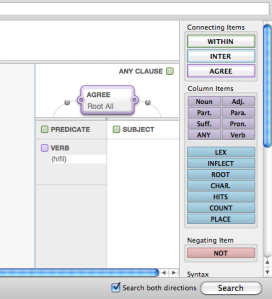In my reading on the cognate accusative in Biblical Hebrew, I’ve noticed that verbal semantics have been somewhat neglected. There are two aspects of verbal semantics that interest me based on the theoretical framework I developed for my dissertation:
First, to what degree does the event fit the transitive prototype? The canonical transitive clause has both grammatical and semantic aspects that line up as follows:
| Grammatical Role |
Subject |
Object |
| Semantic Role |
Agent |
Patient [1] |
Second, to what degree are the verb and object inherently related? Put differently, to what degree does the object add semantic information about the nature of event and to what degree can it exist independently of the event?
The cases that are most interesting linguistically are those in which the event deviates significantly from the transitive prototype and there is a strong inherence between object and verb.
First, consider a phrase like וַיַּעֲלוּ עֹלֹת “They offered burnt offerings” (Exod 32:6). This would seem to fit the semantic prototype since the עֹלֹת are affected/effected patients that undergo a change-of-state. Further, עֹלֹת seems to be semantically meaningful since you can העלה a wide variety of things besides עֹלֹת. Indeed, it is the presence of an object such as עלה, מִנְחָה, זֶבַח, or פַּר that invokes the specific semantic frame of sacrifice in the context of העלה rather than the more generalized meaning “to bring up”. Frankly, there is nothing particularly interesting here about the cognate nature of the accusative.
A phrase such as נִלְבְּנָה לְבֵנִים “Let’s ‘brick’ bricks” (Gen 11:3) would seem to be a middle case. On the one hand, it clearly patterns with verbs of creation where לְבֵנִים fills the role of effected patient; therefore, it fits the transitive prototype semantically. Of course, can you לבן anything else besides לבנים? This makes לבנים redundant, and liable to indefinite object deletion.[2] For instance, מַדּוּעַ לֹא כִלִּיתֶם חָקְכֶם לִלְבֹּן “Why have you not finished your order to ‘brick’?” (Exod 5:14).
Finally, we have cases such as חֲטָאתֶם חֲטָאָה גְדֹלָה “You have sinned a great sin” (Exod 32:30) and וַיֶּחֱרַד יִצְחָק חֲרָדָה גְּדֹלָה “Isaac trembled a great tremble” (Gen 27:33). Neither חטא nor חדר fit the semantic prototype. For instance, חטא (Qal) returns 181 hits in the MT, but I only count two cases in which it governs an object (Exod 32:30 and 32:31) and both of these are cognate accusatives and qualified. Here, an otherwise intransitive verb is massaged into the transitive prototype by treating the phrase חֲטָאָה גְדֹלָה as an effected object which was created by the action of sinning. These are what I would consider proper cognate accusatives (or at least interesting cognate accusatives). [3]
In summary, the basic description of a cognate accusative is an accusative phrase that shares the same root (or a closely related root; note we haven’t really looked into these) as the verb. To analyze the significance of this construction I would divide the data based on noun phrase type and verbal semantics. First, is the accusative a bare indefinite noun phrase or qualified in some manner. Second, to what degree does the clause fit the semantic prototype and what is the inherence relationship between accusative and verb.
___________
[1] An effected patient is created by the action of the agent, while an affected patient undergoes a resulting change of state due to the action of the agent.
[2] Indefinite object deletion is a phenomenon in which the object in a semantically transitive clause may be omitted if it is low in referentiality (indefinite) and can be inferred from context. Verbs of eating and drinking, for instance, often allow indefinite object deletion: ויאכלו וישתוּ “They ate and they drank” (Gen 24:54).
[3] One caveat—be careful about making assumptions concerning whether a verb is “transitive” or “intransitive.” Verbs on the boundaries are often treated differently by different languages.




